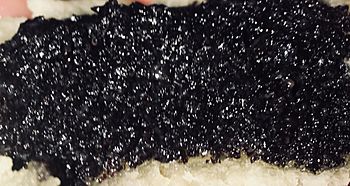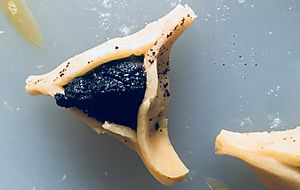Poppy seed paste facts for kids

Poppy seed paste used as a filling for hamantaschen
|
|
| Alternative names | Mohn |
|---|---|
| Type | Spread, pastry filling |
| Main ingredients | Poppyseeds (additional ingredients include sugar or honey and milk or water |
Poppy seed paste, also known as mohn, is a popular ingredient in Jewish desserts and pastries. It is made from ground poppy seeds mixed with sweeteners. You can find this filling in treats like mohn kichel, babka, and especially hamantashen. In Jewish cooking, this filling is often called mohn, which is the word for poppy in both Yiddish and German. Pastries filled with poppy seeds are a special part of the Purim holiday.
Contents
What is Poppy Seed Paste?
Poppy seed paste is usually a very thick paste. It feels a lot like peanut butter or a thick pudding. Sometimes it can get hard when it's cooked.
It tastes sweet, but it also has a slightly bitter flavor. You might even notice a hint of citrus from the poppy seeds. Sometimes, people add lemon or orange zest to make these flavors stronger. Since the poppy seeds are ground into a powder, they don't get stuck in your teeth as much as whole seeds.
Different Kinds of Poppy Seed Paste
In Ashkenazi Jewish cooking (from Jewish people in Central and Eastern Europe), there are two main types of poppy seed filling. This is because of kosher dietary laws, which are rules about food.
- Dairy mohn: This type can have milk, heavy cream, or butter. It is used in baked goods that are made with dairy dough. These pastries are served with meals that also contain dairy.
- Pareve mohn: This type is non-dairy. It uses water instead of milk and margarine or oil instead of butter. Pareve (pronounced "PAR-ev") means it contains neither meat nor dairy. This filling is used in pastries served with meat meals, like mohn rolls or pareve hamantashen. Pareve poppy seed filling is also great for vegan recipes.
History of Poppy Seed Paste
Poppy seeds were a very popular spice in Central Europe during the Middle Ages. They were known as mohn in German and Yiddish, and mák in Hungarian.
For a long time, poppy seed filling was almost always made at home. When immigrants came to the United States, they brought poppy seeds with them. The first recipes for poppy seed cookies appeared in cookbooks by German-Jewish immigrants as early as 1889.
Store-Bought vs. Homemade
In the 1900s, companies started selling canned poppy seed filling. Brands like "Solo" are still sold today in grocery stores and online. You can find them in parts of the United States with many Jewish people, like the Northeast, Southern California, and South Florida.
Homemade and store-bought fillings can be quite different. Store-bought filling is usually dairy-free. Some people think homemade filling tastes better. This is because packaged fillings often contain ingredients like high fructose corn syrup and preservatives.
Poppy Seed Paste in Holidays
Pastries with poppy seed filling are important in several cultures during holidays. In Ashkenazi Jewish culture, poppy seed-filled hamantashen are a traditional pastry. These are eaten during Purim. Hamantashen means "Haman's ears" or "Haman's pockets." They are one of the most famous uses for poppy seed filling.
How to Make Poppy Seed Paste
Making poppy seed paste starts with grinding the poppy seeds. You can use a coffee grinder, blender, or food processor. Grind them for several minutes until they become a powder. Be careful not to grind them so much that they turn into a paste yet.
Grinding the seeds helps release their natural oils. This makes the final product taste better. It also releases their starches, which help make the filling thicker. Plus, it helps prevent the seeds from getting stuck in your teeth!
Cooking the Paste
Next, depending on the recipe, milk (or water) and sugar (or sometimes honey or silan) are gently heated in a saucepan. They are simmered until the sugar melts and the liquid is hot.
Then, the ground poppy seeds are added. Flavorings like lemon zest or vanilla extract are also mixed in. Sometimes, other ingredients like chopped walnuts are added too. The mixture is stirred constantly until it gets thick, like jam.
After it thickens, it's usually taken off the heat. Some recipes add apricot jam for extra flavor. Cake crumbs or matzo meal might be added to help the paste stick together. This also helps stop the filling from leaking out when it's baked inside pastries.
Finally, the paste is allowed to cool down. It's then put in the refrigerator before being used as a filling or spread. It usually stays fresh for about three days.
Poppy Seed Paste in Other Cultures


